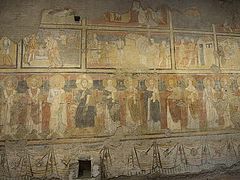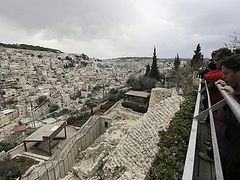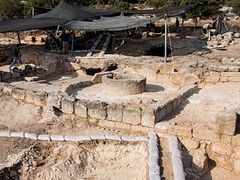Source: Haaretz
April 5, 2016
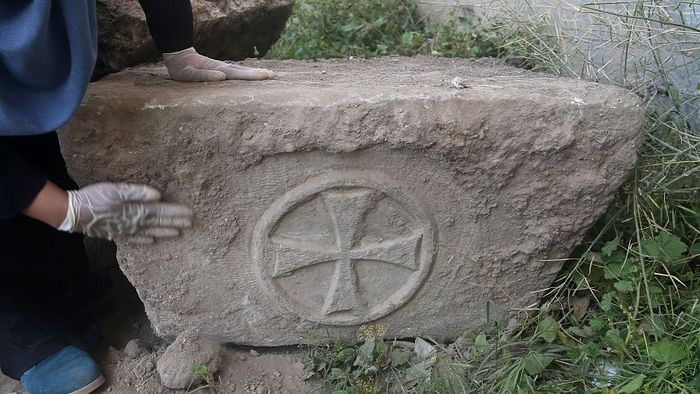 Palestinian archaeologist Hyam al-Betar looks at artefacts excavated during the construction of a commercial building in Gaza City, on April 4, 2016. AFP
Palestinian archaeologist Hyam al-Betar looks at artefacts excavated during the construction of a commercial building in Gaza City, on April 4, 2016. AFP
Construction workers in Gaza have discovered ancient ruins that archaeologists say may be part of a Byzantine church dating from around 1,500 years ago, the Palestinian Tourism and Antiquities Ministry said Monday.
The findings include segments of marble pillars with ornate Corinthian capitals, one nearly three meters long, and a 90-centimeter foundation stone bearing a Greek symbol for Christ. Fifteen pieces have been uncovered, with excavations continuing.
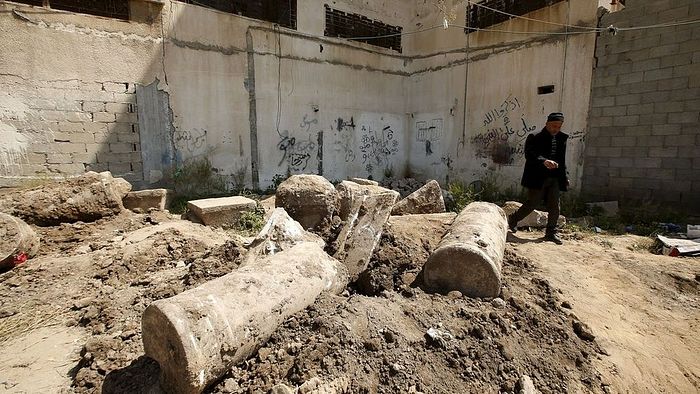 A man walks past ancient ruins which archaeologists say may be part of a Byzantine church or cathedral dating from around 1,500 years ago, in Gaza City April 4, 2016Reuters
A man walks past ancient ruins which archaeologists say may be part of a Byzantine church or cathedral dating from around 1,500 years ago, in Gaza City April 4, 2016Reuters
“Our first thought is that the site is a cathedral or a church from the Byzantine period,” said Jamal Abu Rida, the general director of the antiquities ministry.
“During that era, there was a great interest among the Byzantine rulers to build churches in the Gaza Strip.”
 Palestinian archaeologist Hyam al-Betar looks at artifacts excavated during the construction of a commercial building in Gaza City, on April 4, 2016. AFP
Palestinian archaeologist Hyam al-Betar looks at artifacts excavated during the construction of a commercial building in Gaza City, on April 4, 2016. AFP
Gaza was a prosperous seaport during the Roman period, with a diverse population of Greeks, Romans, Jews, Egyptians and Persians. Pagan temples were destroyed in the late 4th and early 5th centuries C.E. and there was widespread church-building.
That continued until the Muslim general Amr ibn al-As conquered Gaza in 637 C.E., after which most of the population adopted Islam and Christian places of worship were abandoned.
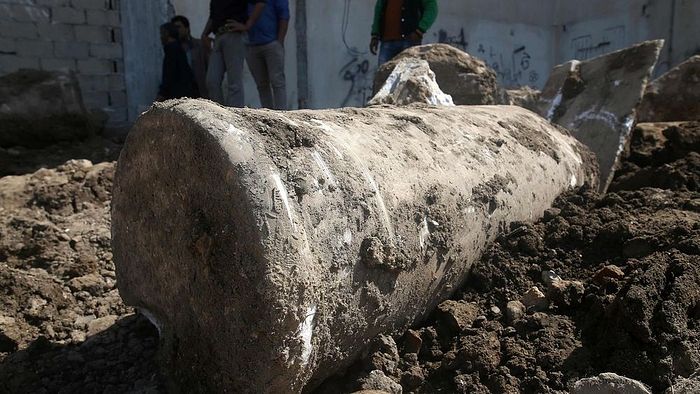 Palestinian workers stand next to archaeological artefacts excavated during the construction of a commercial building in Gaza City, on April 4, 2016.AFP
Palestinian workers stand next to archaeological artefacts excavated during the construction of a commercial building in Gaza City, on April 4, 2016.AFP
“I dare say the place is of historical value,” said Abu Rida, estimating the ruins to date from somewhere between 395 and the late 600s C.E.
Dozens of onlookers watched on Monday as a bulldozer and a digger continued to shift earth in Palestine Square, a busy shopping district in downtown Gaza. Bystanders used their phones to take pictures and video of the archaeological pieces laid out next to the digging site.
The discovery was first made on Saturday, as construction workers prepared the ground for a shopping center. The antiquities ministry was called in and immediately uncovered three large pieces. Then a dozen more were found.
Abu Rida said the preparation for a shopping center may have to be halted should excavations lead to the discovery of more pieces. Construction workers showed no sign of stopping Monday, with diggers shifting huge mounds of earth.
“Our mission is to preserve our Palestinian history before Islam and after Islam,” said Abu Rida.
Over the millennia, Gaza has served as a trading post for Egyptians, Philistines, Romans and Crusaders. There are ruins from Alexander the Great’s siege of the city and the arrival of the Islamic armies some 1,400 years ago.
Several discoveries have been made in recent years but a lack of funding and skills has hindered the ministry’s ability to excavate and preserve the findings, Abu Rida said. His ministry employs just 40 excavation workers.
“The site we are talking about is 2,000 square meters and 10 meters deep and requires hundreds of workers and millions of dollars to carry out proper excavation to extract pieces and read the texts written on them,” he said.
The site is located not far from Gaza’s old spice market, near the ancient Omari Mosque, built a thousand years ago, and the Church of Saint Porphyrius, dating from the 5th century.

